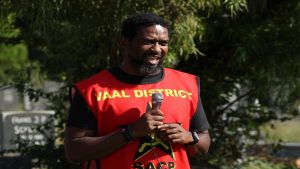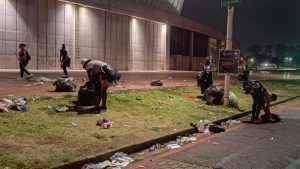Waiting for the Western Cape Department of Education to amend the National Guidelines on School Uniforms to accommodate non-binary learners, schools are confronted with addressing structural systematic issues surrounding neutral school uniforms and its impact on learners of the LGBTIQA+ community.
“Everyone should wear what they are comfortable wearing,” says 14-year-old high school learner Charlin Stevens schooling in the Western Cape.
Speaking from a yellow painted classroom plastered with positive affirmations, a sharp contrast from its littered surroundings, Stevens says here learners from the LGBTIQA+ community can express themselves without hesitancy.
An anonymous Grade 9 learner, cited hurdles facing non-binary pupils, with the biggest one being, acceptance.
“I know some people who are not actually straight, but they are scared of what other people might think of them and what their family members would say. For example, if you come from a Christian family, I feel like they would not actually accept you for who you are,” the learner elaborates.
Learners revealed that the struggle for acceptance beyond schoolyards is hardest at home, where learners are subjected to constant ridicule and discrimination.
“I want to educate them about my sexuality but their assaults on me would hurt my feelings in a way that sometimes I couldn’t talk. Even my family used to discriminate against me in a lot of things many times at family gatherings. I would wear what I feel like I want to wear and my mother would say, ‘I didn’t give birth to a boy, I gave birth to a girl’,” says Iviwe Mkeyiya, a Grade 9 learner.
A school bell chimes, ending the midday break, and one can see learners in burgundy skirts and gray pants bustling to classrooms.
Lanrich Du Plessis, a high school learner, says schoolyard bullying taught him to embrace his sexuality.
“I play with boys soccer, but at the end of the day they would bully me, so at the end of the day I wouldn’t play with boys anymore, I start playing with girls,” says Du Plessis with a broad smile.
Responsible for overseeing the administration of the school, Delft Technical School Governing Body (SGB) member Michelle Behadien says, “This is one of the policies that we as the SGB, we haven’t considered it much, because we never thought that there was a problem, but speaking about it now and listening to them (learners), I do realize that this is something that we need to speak about.”
“We want to go back to our learners and find out what they would prefer to wear,” Behadien suggests.
A life-orientation teacher, Asheeqah Petersen, at the same school wants everyone to be themselves.
Speaking on gender fluidity, Peterson says, “For me, it’s how learners or individuals express themselves. Basically putting out who they are.”
It’s not only learners of sexual minority groups fighting for inclusive rights, teachers from the LGBTQIA+ community are advocating for inclusivity despite the backlash.
Crogen Petersen, a gay teacher at Delft, said prior to changing the school’s uniform, the school’s first code of conduct was very strict on how boys and girls should dress.
According to Petersen, learners were encouraged to participate in creating a school uniform that they preferred.
Transgender primary school teacher, Larissa Gordon says, “I think now with my journey being transgender, I came to the school being male, I now identify as a transgender female. I had to change narratives in terms of being addressed as a man. I think children are so aware of how society has changed and the different genders they come across or encounter.”
Elizabeth Muller, a parent of a learner schooling at Delft Technical High, says conversations on non-binary school uniforms should be led by the learners. “It would be nice for all of us to sit together and discuss the matter.”
Urging the Department of Basic Education to review the existing draft national guidelines on school uniforms in a media statement, the Commission for Gender Equality says guidelines continue to “reinforce the sexist and discriminatory separation of girls and boys, leaving little room for non-binary learners to be able to wear uniforms that fit their gender expression”.
According to the commission, a review would confront bullying and deprivation of equal access to education for non-binary learners.
IAM’s Marlow Valentine says there is little support for sexual minority groups in schools. “When it comes to uniforms of learners, particularly within primary schools, you find that teachers, educators and principals don’t understand the structural systemic issues surrounding uniforms.”
According to the advocacy organization, some learners struggling with wearing gendered school uniforms stop going to school.
“Unfortunately in terms of culture and language, our learners within rural areas still lack behind. We find that teachers are not really progressive because they don’t have access to information,” Valentine adds.
Julian Davids from Triangle Project says social workers provide psycho-social services to learners who struggle with the school environment that is not catering to their needs as a gender diverse or sexual identity that is challenged at school.
Western Cape Education Department spokesperson Bronagh Hammond says, “We are in the process of finalisng the guidelines of gender identity and sexual orientation in public schools of the Western Cape.”
“The purpose of the guideline is to create an educational environment that does not discriminate directly or indirectly against anyone on one or more grounds including gender, sex. Sexual orientation, conscience, belief, culture and birth amongst others, and also to create an educational environment that is free from stigma and discrimination for all learners and all public schools. And to promote gender identity and gender,” Hammond adds.
The department will release the guidelines this year.
This story was compiled by Selloane Khalane and Reginald Witbooi






